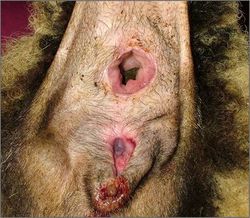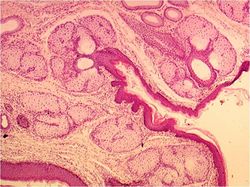Difference between revisions of "Anus - Anatomy & Physiology"
Fiorecastro (talk | contribs) |
|||
| (44 intermediate revisions by 5 users not shown) | |||
| Line 1: | Line 1: | ||
| − | + | {{OpenPagesTop}} | |
| − | + | ==Overview== | |
| − | + | The anus is the terminal portion of the '''alimentary tract''' which communicates with the external environment. Two '''sphincters''' control it's aperture. It allows faeces and gas to leave the body. '''Defeacation''' is the process where faeces are expelled from the [[Rectum - Anatomy & Physiology|rectum]] through the anus. | |
| + | ==Structure== | ||
| + | [[Image:Sheep Anus.jpg|thumb|right|250px|Anus (Sheep) - © RVC 2008]] | ||
| − | + | There are ''two'' anal sphincters: | |
| − | + | The '''internal anal sphincter''', formed by the thickening of the circular smooth muscle of the gut and under autonomic control and the '''external anal sphincter''', formed from striated skeletal muscle and under voluntary control. | |
==Function== | ==Function== | ||
| + | The function of the anus is to transmit faeces from the '''rectum''' to the external environment. '''Anal sphincters''' give control over the regularity of defeaction, and this may be consciously controlled in some species. The '''anal canal''' lubricates the passage of faeces. | ||
| − | == | + | ==Species Differences== |
| + | ===Carnivore=== | ||
| + | The dog and cat posses two '''anal sacs'''. In the dog, these are the size of a hazlenut. They are located ventrolaterally between the internal and external anal sphincters. They are large, coiled apocrine tubules that have many '''tubuloalveolar glands''' in their walls. These '''tubuloalveolar glands''' produce a fatty secretion. The '''fundus''' of the sac secretes a potent smelling fluid that drains through a single duct to an opening near the '''anocutaneous junction'''. | ||
| − | + | The anal sacs get compressed during defecation, which causes the fluid to be expressed. The scent of the fluid is thought to act as a territorial marker. | |
| + | Anal sacs are clinically important as they are commonly [[Anal Sac Disease - General|diseased]] in dogs - frequently, they become enlarged due to accumulated secretion. The '''dog''' has '''perianal glands''' that lie in the skin surrounding the anus. They are modified sebaceous glands. | ||
| − | == | + | ===Equine=== |
| + | Click here for information on the [[Alimentary System - Horse Anatomy|equine]] anus. | ||
| + | ===Porcine=== | ||
| + | Also have '''anal sacs'''. | ||
==Histology== | ==Histology== | ||
| − | |||
| − | |||
| − | |||
| − | |||
| − | |||
| − | |||
| − | |||
| − | |||
| − | |||
| − | |||
| − | |||
| − | |||
| − | |||
| − | |||
| − | |||
| − | |||
| − | |||
| − | |||
| − | + | [[Image:Anal Glands.jpg|thumb|right|250px|Anal Glands- © RVC 2008]] | |
| + | At the anus, the '''columnar intestinal epithelium''' is replaced by the '''stratified squamous keratinised epithelium''' of the skin. The '''anal canal''' joins the bowel to the exterior and is the last 2-3cm of the alimentary tract. This is a short passage derived from the '''proctodeum''' (formed by invagination of the surface ectoderm). Sebaceous and large apocrine sweat glands both occur in this region in association with the anal sphincters. Before joining the anal canal, the rectum becomes dilated to form the ''rectal ampulla''. At the '''rectoanal''' junction, the lumen is constricted by longitudinal folds in the mucosa, these are normally pressed together to occlude the lumen. As the muscosa changes from columnar to cutaneous, three zones are created: | ||
| + | |||
| + | '''1.Columnar''' | ||
| + | |||
| + | The columnar zone has many longitudinal folds. It can be divided from the rectum by the ''anorectal line''. This is a line where the mucosa is stratified squamous epithelium containing lots of lymphoid tissue. | ||
| + | |||
| + | '''2.Intermediate''' | ||
| + | |||
| + | The intermediate zone can be divided from the cutaneous zone by the ''anocutaneous line''. | ||
| + | |||
| + | '''3.Cutaneous''' | ||
| + | The cutaneous zone is the skin. It is stratified squamous keratinised epithelium that surrounds the anus. The excretory ducts of the '''anal sacs''' open into this region. | ||
==Links== | ==Links== | ||
| + | '''Click here for information on the [[Intestines, Small and Large - Pathology|Pathology Of The Small and Large Intestines]].''' | ||
| + | |||
| + | |||
| + | |||
| + | [[Category:Large Intestine - Anatomy & Physiology]] | ||
| + | [[Category:A&P Done]] | ||
Latest revision as of 17:11, 7 December 2022
Overview
The anus is the terminal portion of the alimentary tract which communicates with the external environment. Two sphincters control it's aperture. It allows faeces and gas to leave the body. Defeacation is the process where faeces are expelled from the rectum through the anus.
Structure
There are two anal sphincters: The internal anal sphincter, formed by the thickening of the circular smooth muscle of the gut and under autonomic control and the external anal sphincter, formed from striated skeletal muscle and under voluntary control.
Function
The function of the anus is to transmit faeces from the rectum to the external environment. Anal sphincters give control over the regularity of defeaction, and this may be consciously controlled in some species. The anal canal lubricates the passage of faeces.
Species Differences
Carnivore
The dog and cat posses two anal sacs. In the dog, these are the size of a hazlenut. They are located ventrolaterally between the internal and external anal sphincters. They are large, coiled apocrine tubules that have many tubuloalveolar glands in their walls. These tubuloalveolar glands produce a fatty secretion. The fundus of the sac secretes a potent smelling fluid that drains through a single duct to an opening near the anocutaneous junction.
The anal sacs get compressed during defecation, which causes the fluid to be expressed. The scent of the fluid is thought to act as a territorial marker.
Anal sacs are clinically important as they are commonly diseased in dogs - frequently, they become enlarged due to accumulated secretion. The dog has perianal glands that lie in the skin surrounding the anus. They are modified sebaceous glands.
Equine
Click here for information on the equine anus.
Porcine
Also have anal sacs.
Histology
At the anus, the columnar intestinal epithelium is replaced by the stratified squamous keratinised epithelium of the skin. The anal canal joins the bowel to the exterior and is the last 2-3cm of the alimentary tract. This is a short passage derived from the proctodeum (formed by invagination of the surface ectoderm). Sebaceous and large apocrine sweat glands both occur in this region in association with the anal sphincters. Before joining the anal canal, the rectum becomes dilated to form the rectal ampulla. At the rectoanal junction, the lumen is constricted by longitudinal folds in the mucosa, these are normally pressed together to occlude the lumen. As the muscosa changes from columnar to cutaneous, three zones are created:
1.Columnar
The columnar zone has many longitudinal folds. It can be divided from the rectum by the anorectal line. This is a line where the mucosa is stratified squamous epithelium containing lots of lymphoid tissue.
2.Intermediate
The intermediate zone can be divided from the cutaneous zone by the anocutaneous line.
3.Cutaneous
The cutaneous zone is the skin. It is stratified squamous keratinised epithelium that surrounds the anus. The excretory ducts of the anal sacs open into this region.
Links
Click here for information on the Pathology Of The Small and Large Intestines.

